Australia’s largest integrated energy company, AGL Energy, says Australia’s transition away from a coal power dominated national grid to low-carbon generation will largely bypass “baseload” gas, and instead shift straight to large-scale wind and solar.
As politicians and the gas lobby expend considerable energy over the need to guarantee supply of gas, the company founded some 180 years ago as The Australian Gas Light Co, says the combination of wind and solar and battery storage is already cheaper than new gas generators.
“The energy transition we have all been anticipating will skip ‘big baseload gas’ as a major component of the NEM’s base-load generation and instead largely be a case of moving from ‘big coal’ to ‘big renewables’,” AGL CFO Brett Redman says in a presentation to the Macquarie Australia Conference in Sydney on Tuesday.
The frank prediction – which flies in the face of Prime Minister Malcolm Turnbull’s plan to subsidise the delivery of more gas into Australia’s electricity market – is based on the now fairly well accepted economic view that gas power will continue up the cost curve, making it less and less competitive with large-scale solar and wind.
Redman says that based on AGL’s latest analysis, the levelised cost of wind generation is currently at about $A65/MWh and the equivalent cost of solar is about is around $75/MWh.
And while that cost increases to about $100/MWh for wind and $125/MWh for solar when you add gas peaking to balance the renewables output, it still beats the cost of using gas outright, for baseload generation.
Indeed, according to AGL, the price of new baseload gas sits at between $100-$130/MWh – and “that’s not including a carbon cost,” Redman adds. And wind and solar costs, along with battery storage, continue to fall dramatically.
“On these numbers, it’s easy to see how, in an environment where the cost of renewables is falling and the gas price is high, a long-term investment case for baseload gas might not stack up,” Redman told the conference.
“In Australia, this points to gas having a near-term role to continue to firm renewables via gas peakers – but not being the lowest cost replacement for baseload coal,” he added.
“The market already demonstrates this view.”
And indeed it does. As more an more of the world’s big investment dollars – including from Macquarie Group itself – are poured into large-scale renewable energy projects, fewer and fewer are being invested in new gas and coal, despite the Australian federal government’s best efforts to counter that trend.
And that view is also demonstrated in the prices of deals being done. As we reported here, Tony Concannon – the former head of the now-retired Hazelwood coal power station, and current head of Reach Solar Energy – cites a quote given to the company for a large solar farm (100MW) with a significant amount of battery storage.
“Reach received estimates in late December 2016 for solar PV and energy storage (40MWh to 100MWh) which translated into a tariff between $110/MWh to $130/ MWh,” Concannon wrote.
“This is already competitive with gas-fired CCGT and costs are expected to reduce further.”
But where AGL’s view of the not-too distant future NEM differs from others is in the division between “big renewables” and distributed energy resources like rooftop solar and storage.
While other major analyses on the subject see rooftop solar being a major contributor to the future renewables mix – the CSIRO-ENA Electricity Network Transformation Roadmap, for example, has forecast 80GW of installed rooftop solar by 2050, alongside 97GWh of battery storage – AGL’s forecast is for a total of 15GW by 2050.

“Rooftop space is limited compared with demand, so while rooftop solar will deliver some of what is needed, the majority still looks like coming from grid-scale installations,” Redman explained to the conference.
That difference might simply be a case of wishful thinking on behalf of each party. The networks, because everyone will need to share whatever generation they are producing or importing, are convinced everyone still needs poles and wires, and may have less need for “gentailers” like AGL.
And AGL, of course, wants to think that even if coal and gas generation does not amount to a significant share of future power supply, it will still be intimately involved in centralised generation of some sort, even if it’s as back-up for wind and solar. The reason for that is maybe that it hasn’t quite figured out the business model when most of supply come from the consumers.
Interestingly, documents released by the Victorian government detailing its $25 million grid-scale battery storage tender have an even less optimistic view of the future role of gas power generation, citing research that finds the fossil fuel no longer competitive with renewables + storage – not even in a peaking power role.
AGL, however, does expect the role of grid-scale energy storage – and particularly battery storage, as costs continue to fall – to be pivotal, too.
“The bow wave of change will be falling battery costs, which will enable big investment in storage, which will in turn enable more investment for renewables and allow coal to close in an orderly
and secure fashion,” Redman said.
“So, policy that enables and supports that falling cost will be welcome.”
So, to sum up – for those, like Deputy PM Barnaby Joyce, who still appear to be completely confused about the energy market state of play – here is one of the “basic assumptions” Redman says AGL is making as it steers its business into the future:
“We are headed for a low carbon future. Absent a staggering change in the scientific consensus and the community’s expectations, it is a matter of ‘when’ and ‘how quickly’ – not of ‘if’.”








